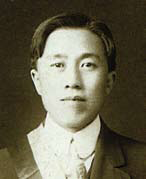Born on May 25, 1879, into a family of ginseng merchants in Kaesong, he boarded the first immigrant ship to Hawaii. At that time, the cost of immigration, which amounted to $100 including the fare and food expenses, was paid in advance by the owner of a sugarcane plantation, with the agreement that it would be deducted from his wages over three years once he started working. Yang Joo-eun worked for three years under this contract and then moved to San Francisco in April 1906.
He was actively involved in the Daedong Patriotic Society and the Korean National Association, and in the early 1940s, he participated in the independence movement as a member of the Korean Volunteer Army. He served as the regional chairman of the Daedong Patriotic Society in Sacramento. In 1913, he was one of the eight founders of the Hungsadan (Korean Patriotic Corps) and held membership number 6. Yang Joo-eun was a key witness to the Stevens assassination incident in 1908, having been present at the San Francisco ferry terminal at that time.
According to his testimony, at that time, Asians were unable to purchase firearms, so Jang In-hwan brought out a gun belonging to a white person living in the same house, while Jeon Myeong-un’s gun was a toy. However, court records indicated it was a real gun.
Yang Joo-eun regretted that he was not quick enough to pick up the briefcase that fell to the ground when Stevens collapsed. He lamented that if they had taken it before the Japanese consulate did, they could have obtained secret documents related to Korea that were inside.
Until 1920, he worked as a tenant farmer in Sacramento, receiving 10% of the harvest from the plantation owner, growing rice and various crops. In the late 1920s, he received a letter from Kim Gu, the head of the Provisional Government, appealing for financial support. He informed the Korean community in San Francisco about this and took the lead in fundraising efforts. At the end of 1941, he established the Korean Defense Corps and received formal approval in February 1942, serving as a member of the corps.
In 1922, he opened a restaurant called “Uncle Sam’s Restaurant” near 30th Street and Chinatown, where he raised a significant amount of money from white customers. The menu included hamburgers and steaks, with a Chinese chef and a staff of six, including Korean Filipinos. He managed the restaurant for 40 years until 1963. He purchased a camera to document the activities of independence activists and social organizations and was also one of the first to own a car in 1920. He married Lee Je-hyun in 1913, with Pastor Lee Dae-wi officiating; she later became the head of the Korean Women’s Patriotic Organization.
Yang Joo-eun was one of the founders of the Korean National Association established in 1909 and was an early member of the Korean Methodist Church in San Francisco. He was a lifelong member of that church for over 70 years. After his marriage, Lee Seung-man stayed at his home for three months due to financial difficulties, and Kim Kyu-sik also stayed there for several months. He provided food, clothing, and shelter to hundreds of students and donated thousands of dollars to support the independence movement and church activities.
He preserved documents and the Shinhan Minbo, the official publication of the Korean National Association, which he collected from 1909 for 50 years, and donated them all to the National Library of Korea in 1961 for research on the Korean immigrant community in the Americas. In 1974, he received the Order of Merit for National Foundation from the Korean government. In 1997, he was posthumously awarded the Order of National Foundation for his patriotism.

Leave a Reply